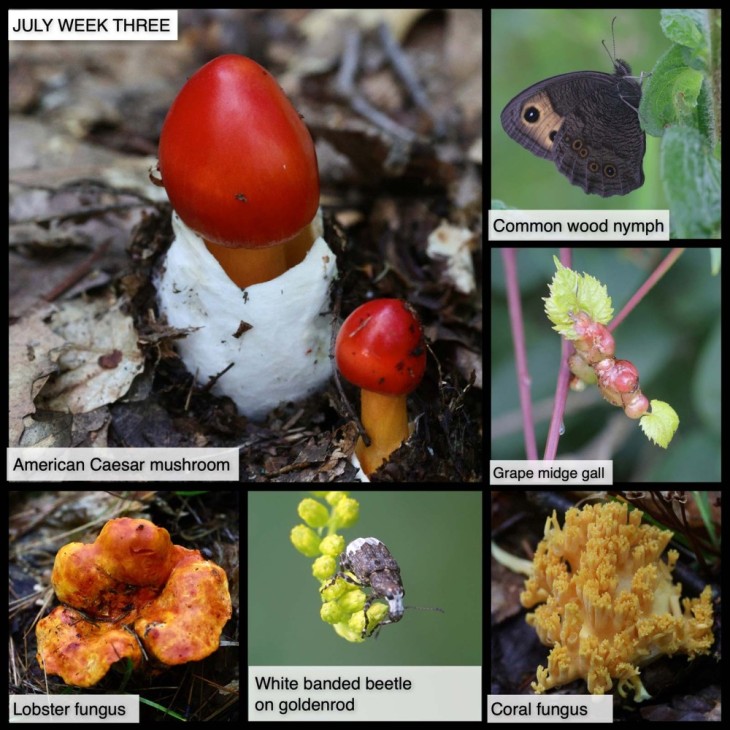This Week in the Woods, after several days of warmth and wet weather, fungi are popping up everywhere, including American Caesar’s Mushroom. Unlike most Amanita species, American Caesar typically has a smooth pileus (cap). When it’s just emerging from its white veil – before it lifts into the typical parasol form – this mushroom resembles a bright red egg, and its appearance can be a shock when you stumble upon one on a brown forest trail. Here’s a post from Mary Holland’s Naturally Curious blog, explaining that the common name of this mushroom derives from its supposed popularity as a dish for Roman emperors (although the farthest back we’ve been able to find this claim is the late 18th century). As Holland notes, most Amanitas are poisonous, so best not to put this on your dinner plate unless you’ve obtained expert identification.
Here are some other nature sights this week (clockwise):
Common wood nymphs have begun to show up in forest-edged fields. As Carolyn Lorié notes in this Outside Story essay, the caterpillars of these July butterflies hatch in autumn, and immediately burrow into the grass, where they hibernate. The caterpillars rouse in late spring, fatten up and pupate, and are just starting to emerge as butterflies now. Watching these insects in her own her garden, Lorié noticed they seem to have a special liking for oregano’s purple blooms.
Those pink bulbs on wild grape stems are grape midge galls, formed when tiny flying insects lay their eggs in the plant’s tissue, along with chemicals that subvert normal growing patterns. Apparently (we haven’t done this), if you cut open a gall, you’ll find bright orange grubs inside. Grapes are susceptible to a number of gall-forming insects. Here’s a fun post from the Ohio State University Extension showing some of them (check out the grape tube gall’s funky devil horns!).
Here’s another one of our favorite fungi discoveries of the week, an apricot-colored coral fungus. There are a number of coral fungi species, and they can change color as they age. See this iNaturalist page for a beautiful gallery of images.
Continuing with this week’s fungal theme, we were surprised to find this little guy clinging to the outer end of a plume of goldenrod. White banded beetles, also called eurymycter beetles (more than one species) are fungus weevils. According to Arthur V. Evans in his book Beetles of Eastern North America, they’re typically found on dead twigs and on fungus growing on beech and other hardwoods.
And finally, not far from American Caesar’s emerging red eggs, we discovered several lobster mushrooms, each a different shape. As we noted last year in a post, lobster mushrooms occur when a parasitic fungus engulfs another mushroom, turning it reddish orange. In addition to the cooked lobster color, lobster mushrooms also sometimes have an unpleasant, fishy sort of smell. Here’s a post about them by mycologist Tom Volk.
Our thanks to The Bailey Charitable Foundation and the Frank and Brinna Sands Foundation for helping to support this series.
In this difficult period, many of us find joy in observing local nature. This series, launched in April 2020, shares nature photographs taken in the past seven days, or in the same week in 2020, most within 15 miles of the Northern Woodlands office in Lyme, New Hampshire. We hope you enjoy using this grid as a prompt for your own explorations.
What are you seeing in the woods this week? Share your images with us on Facebook, or submit a special photo for possible inclusion in our monthly online Reader Photo Gallery.


